Bibliometric analysis of acupuncture research through the Web of Science database from 1990 to 2019
2021-12-04YanQingZhaoLiHuang
Yan-Qing Zhao,Li Huang
1Putuo Hospital,Shanghai University of Traditional Chinese Medicine,Shanghai 200062,China.
Abstract
Background: The main points of focus of bibliometric analysis of acupuncture treatment of diseases include pain(headache, low back pain), insomnia, and knee osteoarthritis, for example.In this paper, we analyze the frontiers,hotspots, and research trends of acupuncture over the past 30 years and compare them for each of three 10-year periods.Methods: All the studies on acupuncture research in three different periods (1990-1999, 2000-2009,2010-2019) were collected from the Web of Science database.The evolution of the research, hotspots, and trends in acupuncture were explored intuitively by analyzing the frequency, betweenness centrality, and subject word clustering of the three periods.Results:(1)1990-1999,the main content relating to research was the mechanism of research of acupuncture treatment of pain.Naloxone was the high-frequency subject word,and centrality included,for example, the spinal cord, enkephalin, smoking cessation, and detoxification.The results of keyword cluster analysis showed that the main research content included capsaicin-induced neurogenic edema, chemical dependency treatment, afferent fiber, and sufferers from xerostomia.(2) 2000-2009, during this stage, the frequency of keywords appeared in new research content such as randomized controlled trials of acupuncture and low back pain, but pain still dominated the main research content.From the perspective of intermediary centrality,along with the rise in randomized controlled trials, there were many important meta-analyses, as well as the management of acupuncture treatment.The main elements of the keyword cluster analysis included, for example,systematic review, randomized controlled pilot study, add-on therapy, brief overview, and ovarian morphology.(3)2010-2019,during this period,compared with the previous two stages,there was increased frequency of keywords,a growth in clinical randomized controlled trials, and distribution of centrality was evident in the emergence of acupuncture in care, osteoarthritis treatment, and breast cancer research.The keyword clustering covered, for example, neural specificity,inflammatory reaction,chronic pain, sleep pattern, and consort statement.Conclusion:This article summarizes the trend of development of acupuncture from 1990 to 2019 and compares the main research categories and hotspots in each of three different 10-year periods within this span, thereby helping elucidate the research direction within the field.
Keywords:Acupuncture,Research categories,Research hotspots,Pain,Naloxone,Bibliometric analysis
Background
Acupuncture is becoming increasingly favored by people worldwide, and it is now a popular supplementary and alternative therapeutic method in many countries.Dating from before 168 B.C.E., the earliest existing acupuncture literatureMoxibustion Classic of Foot and Arm Eleven ChannelsandMoxibustion Classic of Yin Yang Eleven Channels(unknown author)discussed the method of locating the 11 meridians in the human body,moxibustion methods,and indications for these meridians.There are many articles on acupuncture theory and clinical treatment in theYellow Emperor's Classic of Internal Medicine(unknown author,from 99 B.C.E.to 26 B.C.E.),which marks the formation of acupuncture theory.Subsequently, theA-B Classic of Acupuncture and Moxibustion(written by Huangfu Mi from 256 to 260 C.E.) played a connecting role in the development of acupuncture and moxibustion.After the development of each dynasty in ancient China, it became more and more perfect.With the development of science and technology, acupuncture and moxibustion are no longer limited to the development of medicine in China, and their therapeutic effects have been recognized worldwide.In 1979, the World Health Organization recommended the use of acupuncture and moxibustion in treatment of 43 kinds of diseases.In April 2009, the Canadian health care system officially incorporated acupuncture and moxibustion.On October 24, 2018, the United States signed the H.R.6 Act and included acupuncture and moxibustion in the federal medical insurance program.These things are of great significance for the global popularization of acupuncture and moxibustion.The aim of this study is to clearly understand the development of acupuncture research over the past 30 years.
Bibliometric analysis is a scientific method for studying publications on a given topic [1], and it is a widely used quantitative method for assessing the knowledge structure and development context of various research fields.It has been employed in assessing the productivity of institutions, studying national and international cooperation, and examining the hot spots and frontiers of research in specific fields.CiteSpace is one of the more commonly used pieces of visualization analysis software.
The global popularization of acupuncture has led to a gradual increase of research on acupuncture(including literature research).Bibliometric analysis of acupuncture incorporates statistics on the scientific research output of different countries.Studies include an analysis of the current status of global and Brazilian acupuncture studies from 2000 to 2014 [2], a bibliometric analysis of randomized controlled trials(RCTs) of acupuncture in Korea [3], and a 1988-2017 analysis of acupuncture literature in Taiwan [4].These studies greatly facilitate understanding of the trends of acupuncture research in different regions.
Secondly, it is a bibliometric analysis of acupuncture treatment about different diseases.For example, Liang YD [5] utilized CiteSpace software to analyze the literature on acupuncture treatment of low back pain over the past 20 years, Lee IS [6] used VOSviewer software to analyze the literature on acupuncture treatment of pain over the past 20 years,and Pei W [7] carried out a bibliometric analysis of acupuncture treatment for insomnia.Studies such as these can enable scholars to understand the frontiers and hotspots in this field both accurately and quickly.
In the current study, we use CiteSpace software to carry out a visual analysis of the knowledge map of the acupuncture research in the Web of Science database between 1990 and 2019.Through comparison of the keywords of the research literature, we aim to identify the frontiers,hotspots,and research trends in each time node to clarify the sources and evolution of literature on acupuncture research.
Materials and methods
Source of literature
We first searched the Web of Science database using the English keywords: “acupuncture” OR“acupuncture therapy” OR “acupuncture, ear” OR“acupuncture points” OR “acupuncture analgesia”.Second, to avoid omitting research literature, we use,“acupuncture” to search for synonyms in the MeSH database and the subject word database in PubMed,and then we merged the final data.The link to the synonyms' database is as follows: https://www.ncbi.nlm.nih.gov/mesh/?term=acupuncture.Next,is Web of Science database settings: “select database”setting is “Web of Science core collection”.[8] The data were retrieved on April 15, 2020, and the data for the periods 1990-1999, 2000-2009, 2010-2019 were compared and analyzed.
Analysis software
The version of CiteSpace analysis software used was 5.2.R1, this was invented by Professor Chen Chaomei from the Computer and Information Science Department of Drexel University in the United States.It can be used to analyze the structure, laws and distribution of scientific knowledge[9].
Download and import of data
The results retrieved by using subject words were exported, the file format was “plain text”.We used CiteSpace software to remove duplicates and create a unique record,which we then analyzed.
Statistical methods
We conducted keyword analysis of all the acupuncture research literature, keyword frequency identifies the core keywords, and betweenness centrality is an indicator of the importance of nodes in the network used to discover and measure the significance of the literature.Keyword clustering analysis produces a keyword co-occurrence network that can reflect both the current research hotspots in a certain field and the hotspots have been generated in the past.The purpose is to analyze hotspots, trends, and knowledge structure to measure the main research hotspots in a field.CiteSpace software uses Q and silhouette to measure the clarity of clustering.In general,Q >0.3 means that the divided community structure is significant; when the S value is 0.7, clustering is highly efficient and convincing.
Parameter setting
The parameter settings of the CiteSpace software are“time slicing”, which is set to “from 1990 to 1999,from 2000 to 2009, from 2010 to 2019” and “#years per slice: 1, 2, 1”, “node types” select “keyword”,“pruning” selects “pathfinder” and “pruning the merged network”.
Results
We conducted the co-occurrence analysis of keywords for three different time nodes to identify the sources of literature on acupuncture research.In addition to discovering the hot spots of acupuncture research in different periods, we must explore the differences between them.
The first stage(1990-1999)
In the first stage (1990-1999) we identified 936 articles, of which 927 remained after sorting them for repetition.We used the CiteSpace software to obtain the intermediary centrality of the acupuncture research keywords at this stage and create the diagram of the clustering of keywords [4].The clustering analysis graph included 196 nodes and 372 connections, with a density value of 0.0195.The top five keywords identified by keyword frequency distribution were“acupuncture”, “pain”, “analgesia”,“electroacupuncture”, and “rat”.The top five values of intermediary centrality were“mechanism”,“smoking”,“placebo”, “alternative medicine”, and “spinal cord”.Table 1 shows the specific statistical results.
Using CiteSpace software, we clustered the keywords of the acupuncture research, and we obtained 14 categories of acupuncture research:“capsaicin-induced neurogenic edema”, “systematic review”, “chemical dependency treatment”, “Chinese medicine”,“afferent fiber”,“enkephalin-like material”,“eye acupuncture”, “cerebrovascular disease”,“acupuncture”, “brain catecholamine content”, and“xerostomia sufferer”.The specific statistical results are shown in Table 2 and Figure 1.
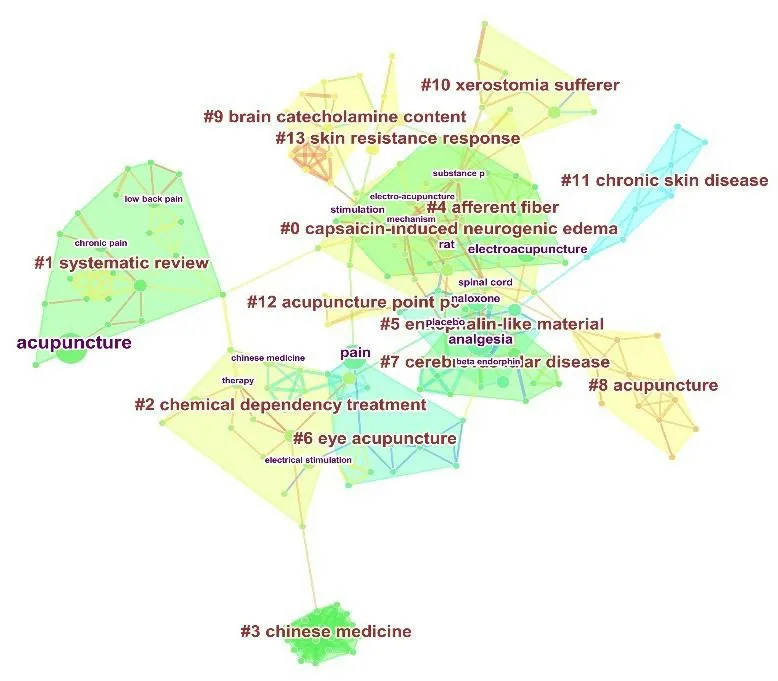
Figure 1 Cluster analysis of keywords in acupuncture research from 1990 to 1999.Nodes of different colors represent different clusters, and the combination of symbols and numbers represents the keywords' study of similar categories; different color block areas represent different research categories,different keywords constitute these categories, and the size of the color block area has no special meaning.
Burst is used to reflect hotspots within a certain time node.The red bar indicates both the duration of the citation explosion and the start and end years of the citation explosion; that is, the red bar represents some frequently cited keywords,and the green bar represents rarely cited keywords[10].The hotspot of acupuncture research between 1990 and 1999 was identified as“naloxone”, and the frontier was identified as the research on “therapy”.The specific results are shown in Figure 2 below.
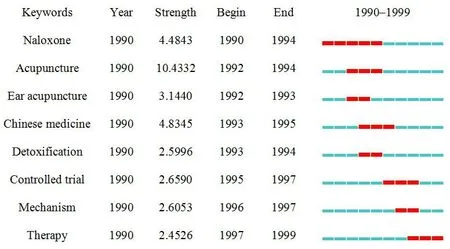
Figure 2 Burst diagram of acupuncture research from 1990 to 1999.The red bar indicates both the duration of the citation explosion and the start and end years of the citation explosion;the longer the red band,the longer the maintenance time of the hot spot on this kind of research, indicating that it is a hot spot in this field; the closer the band to the right, the more recent the study.
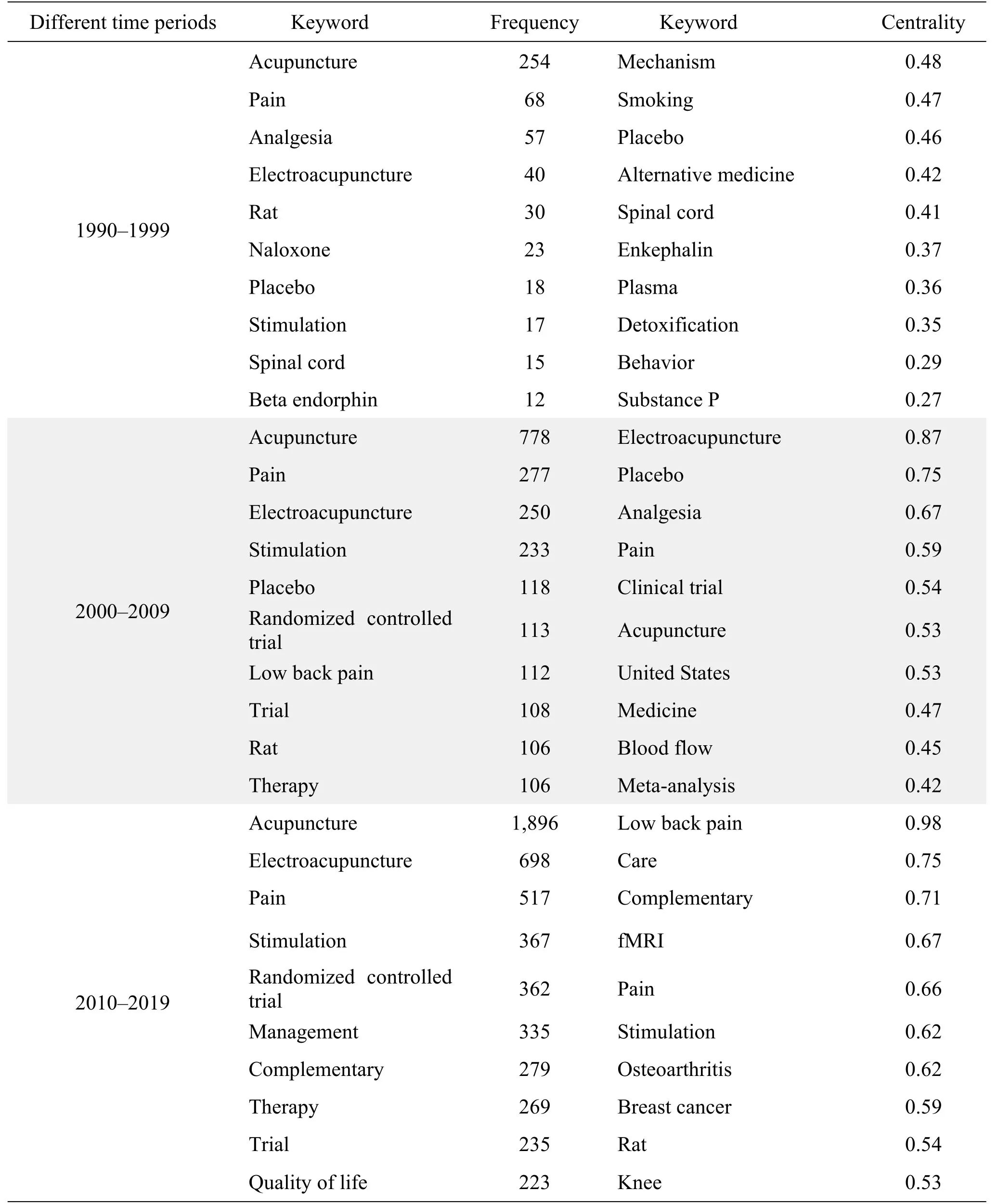
Table 1 Frequency of keywords and centrality distribution of acupuncture research from 1990 to 2019
The second stage(2000-2009)
In the second stage (2000-2009), we identified 2,461 articles, of which 2,430 remained after duplicates were eliminated.We used the CiteSpace software to obtain the intermediary centrality of the acupuncture research keywords at this stage and create the diagram of the clustering of keywords.The cluster analysis graph contained 105 nodes and 107 connections, with a density value of 0.0196.The top five keywords in terms of frequency distribution were “acupuncture”,“pain”, “electroacupuncture”, “stimulation” and“placebo”.The popular keywords during this period were from studies on acupuncture treatment of pain.The top five keywords in respect of centrality were“electroacupuncture”, “placebo”, “analgesia”, “pain”and “clinical trial”.The clinical research into pain was a considerable research node.Table 1 shows the specific statistical results.
We clustered the keywords of the acupuncture studies and obtained 10 categories of acupuncture research: “systematic review”, “delayed onset muscle soreness”, “acupuncture treatment”, “pediatric pain patients” “experience”, “brief overview”, “induced ischemic pain”, “ovarian morphology”, “add-on therapy” and “randomized controlled pilot study”.The specific statistical results are shown in Table 2 and Figure 3.
Burst analysis identified the hot spot of acupuncture research between 2000 and 2009 as being “chronic pain”, and the frontier was “women”.Figure 4 shows the specific results.
The third stage(2010-2019)
In the third stage (2010-2019), we identified 5,174 articles, of which 5,064 remained after the duplicates were removed.We used the CiteSpace software to obtain the centrality of the acupuncture research keywords at this stage and create the diagram of the analysis of the clustering of the keywords.The cluster analysis graph contained 119 nodes and 127 connections, with a density value of 0.0181.The top five keywords in terms of frequency distribution were“acupuncture”, “electroacupuncture”, “pain”,“stimulation” and “randomized controlled trial”.The popular keywords in this stage of the research are constantly appearing growth trend on the basis of the first two time periods.The top five keywords in terms of centrality were “low back pain”, “care”,“complementary”, “functional magnetic resonance imaging (fMRI)” and “pain”.Acupuncture research on low back pain is a newly emerging and important node.Table 1 shows the specific statistical results.
We clustered and analyzed the acupuncture research keywords in this stage and identified 11 categories:“neural specificity”, “inflammatory reaction”, “chronic pain”, “sleep pattern”, “consort”, “statement”,“receptor-positive breast cancer”, “controlled clinical trial”, “adaptive coping strategies”, “auricular acupuncture”, “nurse-led supportive care” and“progesterone level”.Table 2 and Figure 5 show the specific statistical results.
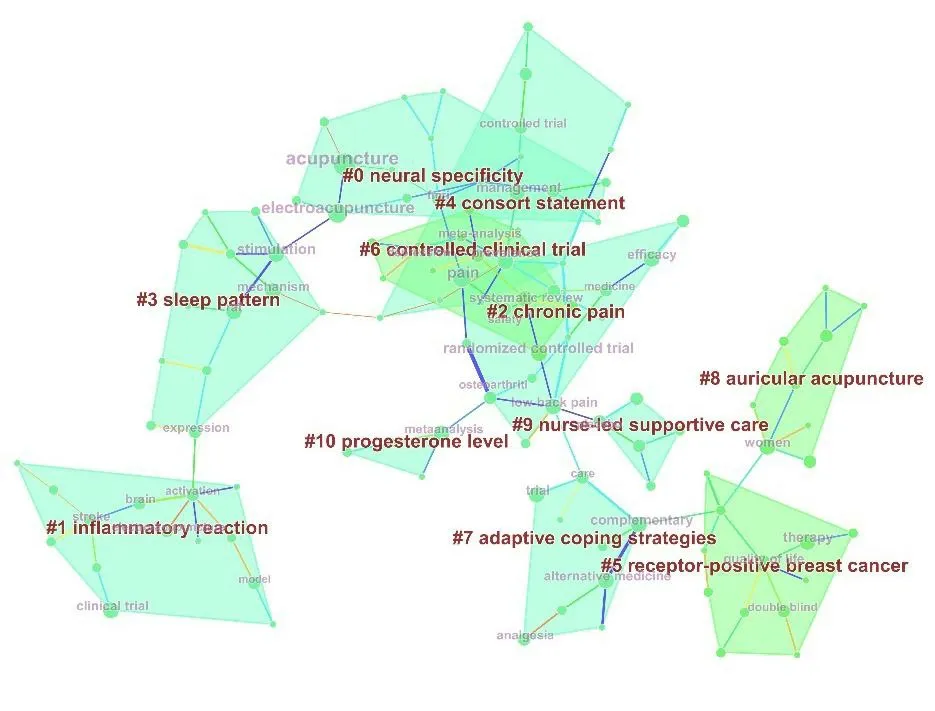
Figure 5 Cluster analysis of keywords in acupuncture research from 2010 to 2019.Nodes of different colors represent different clusters, and the combination of symbols and numbers represents the keywords' study of similar categories; different color block areas represent different research categories,different keywords constitute these categories, and the size of the color block area has no special meaning.
Burst analysis identified the hot spot of acupuncture research between 2010 and 2019 as being the“disease”study of acupuncture treatment.The research frontier was the study of “receptor”.Figure 6 shows the specific results.
Discussion
Bibliometrics is a cross-science of quantitative analysis that all knowledge carriers using mathematical and statistical methods [11].With the advancement of science and technology, bibliometrics provides a reliable method for researchers to deeply understand the research in this field.We have applied co-citation analysis and co-word analysis to studying the keywords of acupuncture research in the Web of Science database to identify, summarize, and compare the trends and characteristics of acupuncture research in different time periods and determine the similarities and differences in acupuncture research during the different periods.
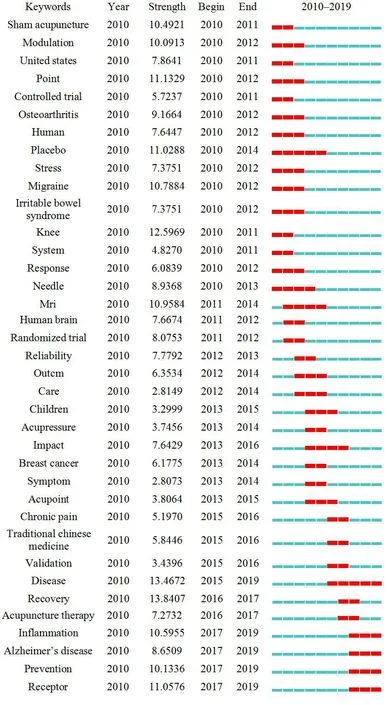
Figure 6 Burst diagram of acupuncture research from 2010 to 2019.The red bar indicates both the duration of the citation explosion and the start and end years of the citation explosion;the longer the red band,the longer the maintenance time of the hot spot on this kind of research, indicating that it is a hot spot in this field; the closer the band to the right, the more recent the study.
Centrality and frequency comparison
There were important studies in the three time periods,including a study of acupuncture treatment of pain and RCTs study.The difference is that another high-frequency keyword was naloxone from 1990 to 1999, related studies have shown endogenous opioids are involved in the acupuncture-mediated antipyretic effect[12],and the centrality also includes spinal cord,enkephalin,smoking cessation,detoxification, etc.The main studies include clinical trials of the effect of acupuncture on smoking cessation and in detoxification in substance abusers.Waite [13] and others have shown that simple ear acupuncture treatment is effective in helping smokers quit smoking.Brewington [14] reviewed the research literature on the use of acupuncture in relieving withdrawal symptoms in drug abusers and showed that acupuncture can help people quit drugs and help detoxify alcoholics who have entered a period of abstinence.A randomized controlled trial of acupuncture treatment of low back pain appeared in 2000-2009.From the perspective of intermediary centrality, with the increase of RCTs, there have also been many important meta-analyses, as well as the management of acupuncture treatment.In 2010-2019,in addition to the increasing frequency of appearance of keywords year by year, some new study keywords appeared, including “care”, “osteoarthritis”, and“breast cancer”.
Comparison of keyword cluster analysis
The same point is that the research category shared between 1990-1999 and 2000-2009 is systematic review, the difference is that the systematic review in 1990-1999 mainly focuses on acupuncture treatment of osteoarthritis [15] and temporomandibular joint function obstacles[16],recurrent headaches[17],acute and chronic low back pain [18], neck pain [19], etc.,and the results of the research require in-depth evaluation and verification of high-quality clinical research.The systematic review in 2000-2009 was not limited to diseases such as pain,but included insomnia[20], depression [21], primary dysmenorrhea [22],menopause[23],Alzheimer's disease[24],and chronic fatigue syndrome [25].Comparison of the similarities and differences between 2000-2009 and 2010-2019,shows that researchers have begun to pay attention to clinical RCTs in both periods.RCTs during 2000-2009 focused mainly on postmenopausal hot flashes [26],childhood asthma [27], and rhinitis [28], and the pattern appearing in 2010-2019 showed that the number of RCTs had grown rapidly during this stage and that the types of acupuncture treatment had expanded still further.For example, thread acupuncture treatment of chronic rotator cuff diseases[29], acupuncture treatment of subjective cognitive decline in the elderly [30], and the use of acupuncture combined with selective serotonin reuptake inhibitors to improve the clinical symptoms and quality of life of patients with depression have emerged[31].Moreover,in the use of acupuncture to treat pain,instead of being limited to simple primary pain, research on pain induced by acupuncture intervention diseases has begun to appear; such research includes the use of ear acupuncture treatment in relieving neuropathic pain caused by spinal cord injury [32] and acute needling with silver needles and warm acupuncture for treatment of lumbosacral disc herniation in adults[33].In addition, there have also been randomized controlled studies in areas such as post-operative complications of acupuncture treatment; laser stimulation of BL10,BL11,GB34 acupoints to prevent vomiting after strabismus surgery [34]; and perioperative disease prevention, such as the use of electroacupuncture stimulation for elderly patients with coronary heart disease.The cardioprotective [35]effects of acupuncture seen during the perioperative period have greatly enriched RCTs of acupuncture treatment of diseases.
The remaining difference lies in the differences in the content of the categories of the respective studies.1990-1999.keyword cluster analysis identified 14 main categories at this stage, mainly including as follows.(1) Capsaicin-induced neurogenic edema:Ceccherelli[36]studied the effect of deep acupuncture on capsaicin-induced edema.Although both deep and shallow thorns were effective, only the deep thorn on the opposite side exhibited a certain therapeutic effect,indicating that the therapeutic effect of the deep thorn is greater than that of the shallow thorn.(2) Chemical dependency treatment: Brumbaugh [37] used acupuncture and moxibustion to relieve acute symptoms of drug withdrawal.This is expected to become an effective alternative therapy for drug abuse.(3) Afferent fiber: Okada [38] found that local application of the capsaicin selective conduction block method detected afferent fibers that may be involved in the suppression of open mouth reflexes.(4)Xerostomia sufferer: Dawidson [39, 40] studied the mechanism of effect of acupuncture on saliva secretion and found that increased release of calcitonin gene-related peptide and the increase of vasoactive intestinal peptide may be factors affecting the flow of saliva in acupuncture treatment.(5) Brain catecholamine content: Toriizuka [41] found that acupuncture plays an important role in improving memory in aging and/or lowering the immune response after menopause.(6)Enkephalin-like material:Bing [42] studied the effect of acupuncture on the activity of enkephalin neurons in the spinal cord.The findings revealed that acupuncture can induce enkephalin in the spinal cord Abnormal activation of neurons.(7) Skin resistance response: Liao [43] found that acupuncture can cause vasoconstriction, thereby reducing the blood flow to the skin and increasing sweating.These are skin resistance reactions and they are the main observation indicators of deh-chi.(8)Acupuncture point pericardium 6 (P6): Schlager [44]conducted a randomized double-blind placebo-controlled study to determine the incidence of vomiting after laser-stimulated P6 decreased significantly.(9) Cerebrovascular disease: Chen [45]analyzed the use of acupuncture to treat hemiplegia after stroke and found that it can not only play a therapeutic role but also prevent cerebrovascular accidents.
2000-2009.The keyword cluster analysis involved 11 main categories, details of some of which are as follows.(1) Add-on therapy: Karst [46] used a randomized single-blind placebo control study to examine the therapeutic effect of acupuncture on 34 patients with alcoholism and found a better effect on the withdrawal symptoms on the 14th day.(2) Brief overview: Mittleman [47] provided an overview of neurophysiology, bioelectricity, and humoral effects,and then briefly summarized the mechanism of acupuncture treatment for diseases.(3) Ovarian morphology: Manneras [48] studied the effect of electroacupuncture and physical exercise on mRNA expression of sympathetic markers in adipose tissue of female rats and in ovarian morphology and found that the occurrence of polycystic ovary syndrome was due to increased sympathetic nerve activity.And exercise can achieve this process by regulating the sympathetic nerve outflow to adipose tissue and ovaries.(4)Pediatric pain patients experience: Kemper [49]described the experience of acupuncture treatment in children with chronic pain through a retrospective case study.The analysis showed that 70% of children and 59% of parents believed that acupuncture treatment can improve symptoms, but in-depth prospective research is required to quantify the costs and effects of treatment.Huebscher [50] conducted a prospective randomized controlled study of the effect of acupuncture on the symptoms and muscle function of 22 patients with delayed onset muscle soreness.(5)Acupuncture treatment: Ahsin [51] found that acupuncture can significantly reduce pain, stiffness,and disability, and that the related physiological changes caused by the treatment exceeded the placebo effect.Chae [52] studied the use of acupuncture and moxibustion in treating Parkinson's disease and used fMRI technology to explore the neural mechanism of the effect of acupuncture on motor function in Parkinson's disease patients.The findings revealed that acupuncture therapy can improve the condition of Parkinson's disease patients through the basal ganglia-thalamic cortical circuit motor function.
2010-2019.The keyword clustering analysis involved 11 main research categories, details of some of which are as follows.(1)Neural specificity:Xue[53]verified the nerve specificity of the block-based general linear model method by acupuncture treatment for the gallbladder 40.The findings revealed that the block-based general linear model method is prone to error and is not suitable for analysis of the neural response pattern caused by acupuncture.Bai [54] used brain fMRI technology to study the nerve specificity of stimulation of acupuncture point P6 in 36 healthy subjects and found evidence that that the specific invasion of the cerebellar hypothalamus and island process after P6 acupuncture has a sedative effect in the treatment of vomiting.(2) Inflammatory reaction:Li [55] conducted randomized controlled animal experiments to examine the effect of acupuncture on the expression of NF-kB (nuclear factor-kB), ICAM-1(intercellular adhesion molecule-1), VCAM-1(vascular cell adhesion molecule-1), mRNA, and protein in the brain tissue of rats with cerebral ischemia-reperfusion injury.The findings revealed that acupuncture can pass through the frontal lobe and the parietal cortex, and other proteins are expressed to improve nerve function.(3) Chronic pain: the study of chronic pain involves two main areas.The first is chronic pain in different parts of the body, mainly involving RCTs of acupuncture treatment of chronic low back pain [56], chronic neck pain [57], chronic migraine [58], chronic shoulder pain [59], and other diseases.The second are is pain caused by disease,which mainly includes chronic hemophilia pain [60],chronic knee pain caused by osteoarthritis [61], and chronic prostatitis-chronic pelvic pain syndrome [62];these are the main areas of chronic pain research at this stage.(4) Sleep pattern: research is mainly focused on the effects of acupuncture on the sleep patterns in insomnia [63], moderate obstructive sleep apnea [64],and intestinal colic [65].(5) Consort statement: it is mainly reflected in the use of the CONSORT statement and the STRICTA standard for the quality assessment of RCT that acupuncture treatment of diseases[66-69].The quality of these RCTs of acupuncture treatment of related diseases is unsatisfactory, and they all need further improvement.(6) Receptor-positive breast cancer: Walker [70] compared acupuncture and venlafaxine treatment in 50 breast cancer patients with vasomotor symptoms.Studies have shown that both treatments can significantly reduce patients' hot flashes, depressive symptoms, and other adverse quality of life symptoms.(7) Adaptive coping strategies: Bussing [71] used a questionnaire survey to assess whether there are differences in social demographic data, adaptive coping strategies, and attitudes toward such therapies between users of acupuncture and homeopathy.The findings revealed that people using acupuncture are more pragmatic and that the expected scientific background of the selected treatment tends to be more obvious.(8) Nurse-led supportive care: Lim [72] studied the changes in the symptoms of 42 patients with incurable cancer after either acupuncture or nurse-led supportive care.The findings showed that acupuncture may be helpful for the treatment of advanced incurable diseases because there are no side effects and good tolerance.Moreover,the therapeutic effect was also prominent, and nurse-led supportive care had a greater impact after a final period of acupuncture treatment for six weeks;thus, it is worth continuing to study this in depth.(9)Progesterone level: Fu [73] showed that acupuncture can improve certain aspects of cholesterol crystal-induced endometrial receptivity in rats during implantation, thereby promoting good reproduction in female rats.
Burst test comparison.The research hotspots in the three time periods evolved from the influence of naloxone on acupuncture analgesia and acupuncture treatment of chronic pain to placebo-controlled trials of acupuncture treatment of various diseases.In addition, the research frontier has transited from the macro level of acupuncture treatment for female diseases to the micro level of receptor research.
Conclusion
In summary, analyzing the hot spots of acupuncture research in three different periods through frontiers,keyword frequency, centrality, and clustering of subject words helps researchers in the field to quickly locate the development and history of the evolution of acupuncture research and to accurately and quickly grasp the research trends in this field.
杂志排行
Traditional Medicine Research的其它文章
- “Banlangen (Radix isatidis) compound granules as a treatment for COVID-19”-the market value of Baiyunshan pharmaceutical soared by 10 billion RMB
- Jian-Gan-Xiao-Zhi decoction ameliorates high-fat high-carbohydrate diet-induced non-alcoholic fatty liver disease and insulin resistance by regulating the AMPK/JNK pathway
- Qiming granule in treating type 2 diabetic kidney disease patients:study protocol for a randomized controlled trial
- Hua-Zhuo-Kai-Yu decoction inhibits apoptosis in nonalcoholic fatty liver disease
- Advances in anti-inflammatory and immunoregulatory mechanisms of sinomenine
- Investigation of in vitro antioxidant activity of dihydromyricetin and flavonoids rich extract from vine tea(Ampelopsis grossedentata)